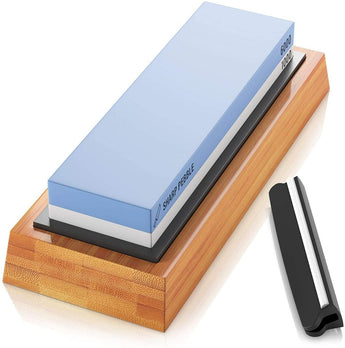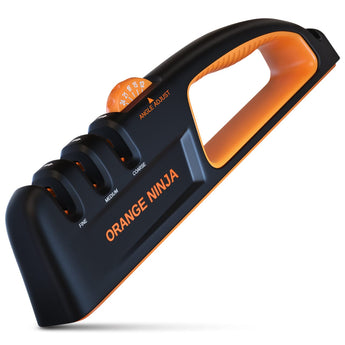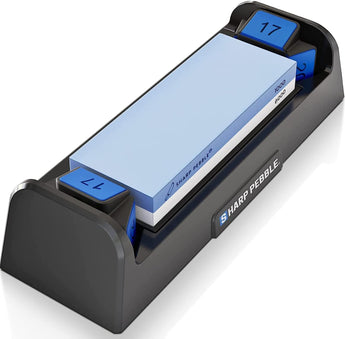Different knives designs are used in each culinary culture to cater for various cooking needs. To avoid a lot of time-wastage, and struggle, knives need to be sharpened so that they carry out their purpose efficiently and accomplish in a desirable quality. In the sharpening, knowing the knife edge angle is a crucial initial step. Various professional chefs and other customers have constantly been asking themselves how they select the right sharpening angle.
What entails a Sharpening angle?
For an average household cook, kitchen blades specs is not a concern. What most individuals do is to select affordable knives that are sharp to some extent to undertake the job well. However, for a novice cook, things are different. A novice cook will need a knife sharpener and have knowledge of how to sharpen each blade in a certain degree.
According to knife specialties, the blade degree varies depending on the diverse functions. A prescribed knife angle of 20 degrees would imply sharpening at 20 degrees on each side, which totals to 40 degrees angle. Thus, a knife angle is the angle a knife user holds a knife from the sharpening stone.
On special cases, there is no total knife angle, like some traditional one-sided beveled Asian knives, since only one side is sharpened. For instance, if a one-sided knife is sharpened at 20 degrees, its total angle becomes 20 degrees. When purchasing a knife, it is crucial to inquire whether it is a single bevel or double bevel so that you know how to sharpen it.
A sharpening bevel angle is determined by durability and Sharpness factors. When you use lower angle, the knife will become sharper, thereby, compromising on the durability. However, if you need a durable edge, you should opt for a larger angle. The knife’s use whether chopping wood, cutting vegetables, or filleting a fish, determines its sharpening angle.
A knife’s toughness compared to its hardness
Several people want to work with a high-quality knife made of good steel. For professionals, Rockwell C Scale measures a steel’s hardness. However, the toughness of the blade means that its material can withstand fracture. For instance, the glass may be hard but not tough. When it comes to a knife, increasing its hardness diminishes its toughness. Thus, when manufacturing knives, a balance should be stricken between toughness and hardness, so that it doesn’t break easily or its edge wear out. The sample principle used in manufacturing knives where toughness and hardness are compromised, the same that should be used in compromising sharpening angles.
Setting Angle degree

Degree Angles
Under 10 Degree Angles
These are typically the lowest angles that are applicable on blade edges that cut softer materials. It is easy to maintain edges at the under 10 lower angle without damaging it. Such angles are suitable in sharpening straight edge razors as they make them extremely sharp. Knowledge of the angle is not crucial in some cases as the blades back offer a good guide to follow. Normally, these kinds of edges are sharpened at 7 to 8 degrees angle. It is very easy for a user to damage a straight razor since its edges are very delicate. Caution should be maintained when utilizing a straight razor to avoid damaging its edges.
10 to 17 Degrees Angles
Most available knives can handle a low sharpening edge of 10 to 17 degrees. It’s a very fine angle edge considering that sharpening at such an angle would total 20 to 34 degrees. A knife that is sharpened at such an angle becomes too weak to handle any chopping motion type of work. Its impact can be worse when the blades are made of hard steel which characteristically bristles and therefore more susceptible to damage. However, such a lower angle can be applicable in providing a smooth cutting action to knives that slice meat or cut other soft items.
17 to 22 Degree Angles
The 17 to 22 degrees angle is the typical sharpening angle for most standard kitchen knives. Some knives, especially the Japanese manufactured ones, sharpened at the recommended 17 degrees. On the other hand, Western-style kitchen knives’ favorite sharpening angle is about 20 degrees. From our experience, most kitchen knives are built of tough material that can withstand a sharpening edge of 15 to 20 degrees and still cut well without any issue. Considering that it amounts to a 40 degrees total angle rough treatment of such edges will compromise its durability.
22 to 30 Degree Angles
It is the typical range that most durable knives sharpen. When a user uses a durable blade like a pocket or hunting knives, a blade edge that withstands all kind of pressure is suitable. Such an edge may not only be useful in slicing, and chopping but also grinding, sawing and to some extent screwing things. Such duties require a knife to be both sharp and durable to handle versatile things. That is why an angled edge of 22 to 30 degrees is suitable for such blades are they leave it more durable.
Over 30 Degrees Angles
Any blade that sharpens beyond 30 degree makes the edges highly durable. Such angles are applicable in tools and knives such as cleavers, machetes, and axes. Though its edges will remain durable, its sharpness is diminished. That is why extra strength is required as you use such tools on hard materials like chopping down trees. However, such kinds of blades remain efficient when it comes to such work. When you abuse other knives with suck kind of work, it’s bound to get damaged easily. The benefit of this angle range is that it maintains the durability of tools. Implying that, an axe has to have durable edges to handle tough work that the rest of the blade edges cannot handle.
The next time you sharpen a knife, knows that its purpose will dictate the blade's sharpening angle. More knowledge of the required sharpening angle edge range will ensure that your knife has a longer lifespan.




Hi sharppebble.com administrator, Your posts are always well-supported by research and data.
25° makes quick work for venison in the kitchen. I reckon simply trial & error. Ken Onion knife sharpener is a must for hassle free/user friendly edge
I have been sharpening knives using a Hapstone Pro fixed angle sharpening system for the past 3 years. After reading this article on sharpening angles as compared to my own experience I found the information very accurate. Good job!
I find the sharpening angles very use full.
Very good 👍 explaination thanks.great job.